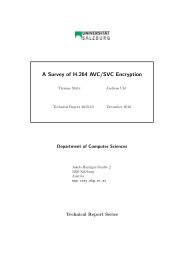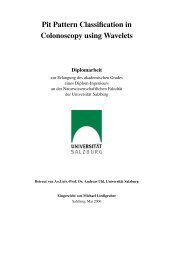Single-sensor hand and footprint-based multimodal biometric ...
Single-sensor hand and footprint-based multimodal biometric ...
Single-sensor hand and footprint-based multimodal biometric ...
Create successful ePaper yourself
Turn your PDF publications into a flip-book with our unique Google optimized e-Paper software.
4 Preprocessing<br />
4.1 Overview<br />
The following information is provided by the preprocessing module in both <strong>h<strong>and</strong></strong>- <strong>and</strong><br />
<strong>footprint</strong>-<strong>based</strong> systems:<br />
• Normalised <strong>h<strong>and</strong></strong>/foot image: this image contains the measured body part with<br />
the following normalisation: (a) segmented from background, (b) aligned in direction<br />
<strong>and</strong> position <strong>and</strong> (c) with removed arm <strong>and</strong> leg parts.<br />
• Contour information: in order to identify fingers/toes within input images, preprocessing<br />
comes along with <strong>h<strong>and</strong></strong>/foot contour information including l<strong>and</strong>mark indices,<br />
such as salient points (i.e. intra-finger/intra-toe valleys <strong>and</strong> finger/toe tips).<br />
This definition implies that each feature extractor is effectively provided with the same<br />
information of the whole <strong>h<strong>and</strong></strong> <strong>and</strong> may discard unused information within a featureextractor-dependent<br />
processing step, before actual extraction takes place. In the strict<br />
multi<strong>biometric</strong> sense of this definition, the employed scenario corresponds to multiple<br />
matcher [14], whereas a slight modification of the preprocessor providing each modality<br />
(fingerprint, palmprint, <strong>h<strong>and</strong></strong> geometry) with already cropped input would classify the<br />
scenario as multiple <strong>biometric</strong>s or multiple units (in case of fingerprints when each fingertip<br />
is processed independently by the same matcher).<br />
H<strong>and</strong>- <strong>and</strong> <strong>footprint</strong>-<strong>based</strong> preprocessing consists of three consecutive steps:<br />
30<br />
1. Segmentation: as introduced before, <strong>h<strong>and</strong></strong> <strong>and</strong> foot only cover parts of the <strong>sensor</strong><br />
image. Thus, a coarse segmentation, by means of detecting the bounding box of<br />
the actual <strong>h<strong>and</strong></strong>print/<strong>footprint</strong>, is applied to increase computation speed of more<br />
complex feature extraction. Segmentation typically also includes binarisation for<br />
masking the background parts in the resulting image using either Otsu’s Thresholding<br />
[29] (for <strong>h<strong>and</strong></strong> images) or Canny edge detection [2] <strong>and</strong> thresholding (for<br />
<strong>footprint</strong>s).<br />
2. Rotational alignment: when using peg-free systems like [43, 18], rotational alignment<br />
has yet to be achieved. A frequently applied method is rigid <strong>h<strong>and</strong></strong> registration<br />
using statistical moments estimating the best-fitting ellipse, a technique from facedetection<br />
[36]. While [43] also proposes finger-alignment for binary images, this<br />
normalisation is not implemented in the proposed system due to textural distortions<br />
caused by different spreadings of fingers. In contrast to more cooperative capture<br />
(like in [18]), problems were experienced using ellipse fitting for <strong>h<strong>and</strong></strong>s with spread<br />
fingers, thus a more elaborate approach was introduced using the palm borderline,<br />
the least-squares approximated line between wrist <strong>and</strong> little finger.<br />
3. Contour extraction <strong>and</strong> salient point detection: For <strong>h<strong>and</strong></strong>-images, intra-finger<br />
valleys (<strong>and</strong> peaks) can be detected as minima (<strong>and</strong> maxima) of the radial distance<br />
function using a reference point at the wrist [43]. In my experiments, this method<br />
is found to be fragile with respect to bad background segmentation, rings (causing<br />
contour artifacts) <strong>and</strong> high resolutions. In this work a new method is proposed,<br />
improving intra-finger valley c<strong>and</strong>idates (provided by the radial distance function)








